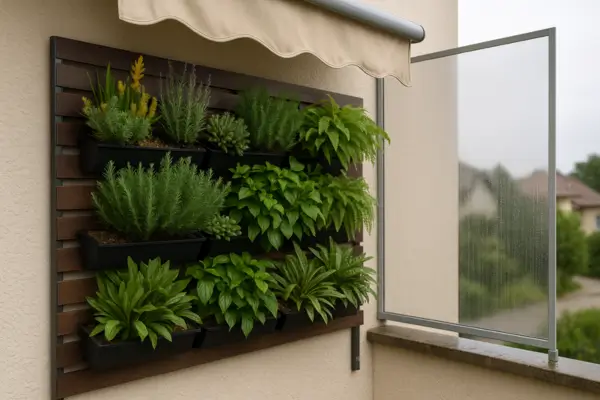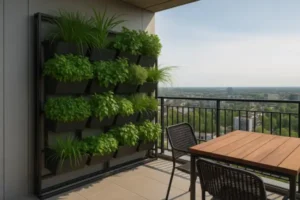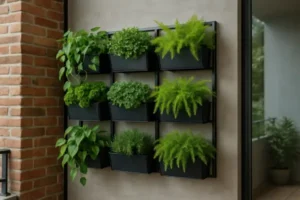How to protect your vertical garden from the weather is one of the first concerns that arise when you decide to build a living wall outdoors. Exposure to wind, sunlight, and high humidity can damage plants, weaken structures, and reduce the overall health of your garden.
Each of these elements demands a specific kind of protection. A windy balcony isn’t the same as a humid patio or a sun-baked terrace. Knowing what to expect helps you act before problems show up.
Whether you’ve just started a small project or invested in a modular vertical garden for gourmet balconies, this guide will give you practical, effective solutions to keep your vertical garden safe and beautiful in all seasons.
How to Protect Your Vertical Garden from the Weather: Understanding the Risks from the Start
Taking care of a vertical garden starts with understanding the weather challenges it will face. How to protect your vertical garden from the weather goes beyond watering and pruning — it’s about managing strong sun, constant wind, and excess humidity.
When these factors are overlooked, they compromise not just plant health but also the durability of the entire structure. Most damage in vertical gardens doesn’t come from sudden events, but from daily exposure and environmental stress.
Start by Analyzing Your Microclimate
The orientation of the balcony is the first thing to assess. West-facing spaces receive intense afternoon sun and need heat protection, while south-facing balconies tend to get less direct light and require shade-tolerant plants.

Higher floors deal with stronger winds, which can dry out the soil quickly and shake plants excessively. Covered balconies, on the other hand, trap more humidity, which encourages fungal growth if there’s not enough ventilation or drainage.
Fully open areas experience accelerated evaporation, which calls for a more efficient irrigation system and plants that tolerate drought better. All of this needs to be considered at the very beginning of the setup.
Mapping out the microclimate — sunlight, wind, humidity, and shade — defines both the limitations and possibilities of your design. By observing these elements closely, you avoid poor choices and reduce the need for constant adjustments later.
For those using a modular vertical garden for gourmet balconies, this attention to detail becomes even more important. These are compact systems integrated into living areas, which demand solutions that are practical, elegant, and efficient.
Every decision, from structural materials to plant species, directly affects the balance of the space. Glass-paneled balconies reflect heat, side walls create wind tunnels, and waterproof floors may trap water, forming moisture pockets.
Paying attention to all these details is the first step toward building a lasting garden. More than just planting, protecting means making sure your effort doesn’t fade over time — but becomes a living, sustainable feature of your home.
Designing a Structure That Resists Wind Without Sacrificing Beauty
Wind is often underestimated when planning a vertical garden, but it can be one of the most destructive elements over time. Constant air movement dries out soil, bends or breaks stems, and gradually loosens support structures if they aren’t reinforced properly.
The first step to avoid long-term damage is solid anchoring. Freestanding gardens should rest on heavy bases or be stabilized with ballast materials. For wall-mounted systems, it’s essential to use galvanized bolts and expansion plugs designed for exterior masonry or brick.
Combine Structural Anchoring with Wind Diffusion
But structural support isn’t enough by itself. You also need to reduce the intensity of wind acting directly on the plants. Instead of trying to block all airflow, which can lead to moisture buildup, the goal is to diffuse the wind and lessen its impact.
One of the most effective strategies is to integrate physical windbreaks into the layout. These elements act as filters, softening the force of gusts while preserving healthy air circulation. At the same time, they can add visual interest and define the space.
Here are a few effective wind-control elements to include in your garden:
- Side screens made of bamboo, wood slats, or acrylic panels
- Dense planters with shrubs or grasses to act as natural barriers
- Trellises or lattices installed behind or around the garden wall
- Built-in vents in modular systems to balance airflow and protection
These additions are particularly useful in a modular vertical garden for gourmet balconies, where exposure to wind is more intense and space is limited. Well-designed modular systems often include these features or make them easy to implement.
Plant positioning also plays a strategic role in reducing wind impact. Place sturdy herbs like rosemary or thyme on the top rows, where exposure is higher. Fragile or trailing species like ivy or pothos should stay at the base, protected by structure and foliage.
Designing with wind in mind doesn’t mean compromising aesthetics. In fact, it helps you build a more harmonious, low-maintenance garden that feels integrated with the space. A garden that stands strong in the wind is one that was designed to last.
Regulating Sun Exposure to Avoid Burn and Dehydration
Sunlight is vital for plant growth, but unfiltered rays can become aggressive—especially during the summer months. In balconies with no natural shade, the garden can overheat quickly, stressing roots and wilting leaves even with regular watering.
One solution is to install retractable sunshades. These can be in the form of fabric awnings, roll-down UV mesh panels, or outdoor curtains that block afternoon rays without completely shading the space. If you prefer fixed solutions, consider polycarbonate panels with UV protection that still allow filtered light through.
Another smart move is vertical layering. Place heat-loving plants like rosemary, oregano, and cherry tomatoes at the top of your garden, where exposure is highest. On the mid-levels, place partial-shade plants like chives or marjoram.
At the base, use low-light options like mint, spinach, or Boston fern. This tiered planting strategy not only creates visual flow—it mimics forest environments, helping plants thrive with the light they naturally prefer.
But sun protection isn’t just about shade—it’s about hydration. Use organic mulch over the planting medium to reduce evaporation and protect roots. Watering should be done early in the morning or at dusk to avoid evaporation loss and minimize the risk of sunburn on leaves.
Managing Humidity and Moisture: A Delicate Balance
Humidity is a natural part of plant life, but in a vertical garden, it must be managed with intention. Excess moisture leads to fungus, root rot, algae growth, and even frame deterioration — especially in semi-enclosed or poorly ventilated spaces.
This is especially common in a modular vertical garden for gourmet balconies, where the system is often close to walls, glass, or ceiling overhangs. These areas trap heat and moisture, creating a humid microclimate that can quickly become problematic.
How to protect your vertical garden from the weather starts by ensuring good drainage. While many modular systems offer basic drain holes or trays, that’s not always enough. The entire setup — from soil to wall — must support water flow and evaporation.
Using the right materials is critical. Breathable substrates like coconut fiber, geotextile felt, or expanded clay promote oxygen exchange and allow water to pass freely, preventing puddling at the root zone or base of the frame.
One small but powerful tactic is tilting the structure forward by a few degrees. This helps gravity move water away from the wall and down into drain gutters or PVC channels, which protects both the plants and the surface behind them.
Create a Ventilation Strategy Alongside Drainage
Drainage alone won’t solve everything if the humidity stays trapped. A successful system must combine water management with proper airflow. Ventilation reduces condensation, discourages fungal spread, and keeps the space fresher overall.
Here are a few effective ways to reduce excess humidity and prevent moisture-related issues:
- Use breathable liners and planting fabrics to promote drainage
- Install a bottom gutter or redirection system to guide runoff safely
- Leave air gaps between planter rows to enhance circulation
- Add cinnamon powder or neem oil to the substrate as a natural antifungal
- Avoid cramming too many plants together — spacing matters
These adjustments work together to regulate internal moisture and reduce stress on your garden. In humid regions, they can make the difference between a thriving wall and one that constantly battles disease.
Consider Passive and Active Airflow Enhancements
In covered balconies or narrow walls, air might not circulate well on its own. That’s when small interventions — like vent grilles behind panels or discreet, USB-powered fans — can dramatically reduce humidity buildup and leaf condensation.
If your garden sits against a warm, reflective surface like tile or glass, consider adding insulation or a breathable backing panel. This helps regulate temperature, reduces surface sweating, and prevents hot, wet air from lingering between layers.
The real goal isn’t to eliminate humidity completely — many plants love moisture. The secret is balance. With the right techniques, you maintain just enough humidity to keep plants hydrated without crossing into dangerous territory.
By managing moisture carefully, you extend the life of both your plants and your structure. And more importantly, you create a low-maintenance, high-performing system that stays healthy through every season.
Choosing the Right Plants for Your Weather Conditions
Selecting the right plants is one of the most effective ways to reduce stress, water waste, and daily maintenance. It’s not just about aesthetics — it’s a smart and natural step in learning how to protect your vertical garden from the weather.
Each plant species responds differently to environmental factors like wind, heat, and moisture. Some are naturally resistant to sun exposure, others thrive in damp air, while a few simply cannot handle intense gusts or prolonged humidity.
In a modular vertical garden for gourmet balconies, where vertical layering is key, choosing the right mix of species can transform your wall into a more stable and self-regulating ecosystem. This approach supports plant health and structural balance at the same time.
The higher sections of your vertical garden will receive more sunlight and wind. These should host sun-loving or drought-tolerant plants that don’t rely on daily care. On the lower levels, where moisture builds up, tropical or shade-loving plants are a better fit.
Match Plant Traits to Microclimate Zones
By grouping plants according to their resilience, you allow each one to thrive in its ideal condition. This strategy also reduces the chance of failure and the need to replace struggling species frequently — a common issue in unplanned gardens.
Here’s a breakdown of plant types by environmental tolerance:
- Hot and sunny balconies: Sedum, lavender, aloe vera, portulaca, zinnia
- Wind-prone areas: Rosemary, liriope, agave, jade plant, coreopsis
- Humid or rainy spots: Boston fern, calathea, bromeliads, pothos, spider plant
When designing the layout, place tougher, compact plants on the upper rows. These act as both protectors and anchors. Mid-range rows can support herbs or flowering varieties that enjoy partial sun, while the bottom row serves as a moisture-friendly zone.
This layered composition does more than look good — it creates microclimates within your vertical system. These zones work together, sharing light, reducing water stress, and improving airflow organically across the entire wall.
Over time, this approach builds a healthier, more efficient garden that evolves with the seasons. Resilient plants not only protect themselves but also shelter nearby species by creating shade, stabilizing humidity, and breaking wind exposure.
Smart selection today saves time and energy tomorrow. The more you align your plants with your environment, the less intervention they need. And that’s the essence of a well-designed vertical garden: beauty through balance, not constant correction.
Maintenance: The Long-Term Secret to Protection
Even the best-designed vertical garden will struggle without regular care. And maintenance, when done consistently, is what truly protects your plants from stress caused by weather shifts.
Your routine should include:
- Weekly visual checks: Look for signs of leaf burn, wind damage, pests, or fungus.
- Soil testing: Use your finger or a moisture meter to ensure neither dry-outs nor saturation.
- Shade adjustments: In summer, increase shading; in winter, let more light in.
- Cleaning: Remove dead leaves, wash dust off foliage, and clean trays to prevent algae buildup.
Don’t forget seasonal changes. Transition to drought-tolerant species before summer, and swap in cold-hardy or evergreen varieties for fall and winter. Modular gardens make this easier because they often allow for tray swapping or panel detachment.
Also, inspect structural integrity every few months. Check for rust, loose brackets, or mold behind panels. A simple 10-minute inspection can save you from a full-system collapse during a storm or prolonged rain.
Frequently Asked Questions (FAQ)
Answers to the most common questions about protecting your vertical garden.
Can vertical gardens withstand strong winds?
Yes — but only when properly designed. A vertical garden can handle windy environments if anchored securely to a stable surface. Adding windbreaks like slatted wood panels or mesh screens helps reduce pressure, and choosing compact, flexible plants prevents stem breakage and leaf tearing during gusts.
How do I prevent my vertical garden from overheating in direct sun?
Start by identifying the hottest hours and areas of your balcony. Use retractable awnings, UV mesh screens, or sheer outdoor curtains to reduce direct exposure. Mulching helps retain soil moisture, and watering early in the day protects roots while avoiding leaf scorch. Layer sun-loving plants at the top and shade-tolerant ones at the base.
What is the best way to manage moisture in humid areas?
Good moisture control starts with excellent drainage. Use breathable fabrics, avoid water-retentive soils, and ensure that water flows freely from top to bottom. Overcrowded plants trap humidity, so spacing is key. To reduce fungal pressure, mix cinnamon powder or neem oil into the substrate every few weeks as a natural preventive.
Do I need to use special materials for outdoor vertical gardens?
Absolutely. Standard materials degrade quickly in changing weather. Prioritize rust-resistant metals, pressure-treated wood, or high-grade plastic composites. These materials are built to endure sun, wind, and rain while supporting plant weight. A weather-resistant frame also protects irrigation components and mounting stability.
What’s the advantage of using a modular vertical garden for gourmet balconies?
Modular systems offer flexibility, efficiency, and a clean, elegant look. They’re easier to maintain, allow for seasonal plant swaps, and usually include built-in drainage and irrigation. That makes them ideal for balconies that face unpredictable conditions, combining visual appeal with functional resilience in small or upscale spaces.
Conclusion
Learning how to protect your vertical garden from the weather is not just about responding to nature—it’s about planning ahead and building with purpose. With the right combination of location awareness, structural design, plant choices, and routine care, your garden becomes resilient, no matter the season.
For those with a modular vertical garden for gourmet balconies, this level of preparation ensures that beauty and function coexist without compromise. Whether it’s wind whipping through high-rise towers or sun beating down on a western wall, you’ll have a system that thrives instead of survives.
Your vertical garden is a living investment—of time, energy, and care. When protected properly, it repays you every day with freshness, peace, and green serenity. Let the weather come. Your garden is ready.




